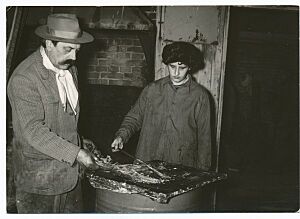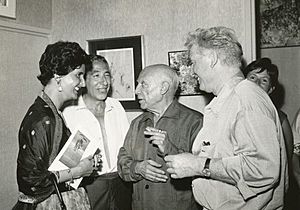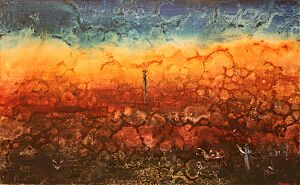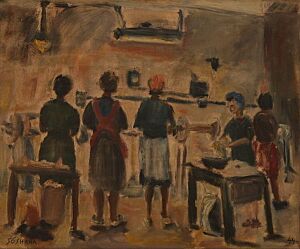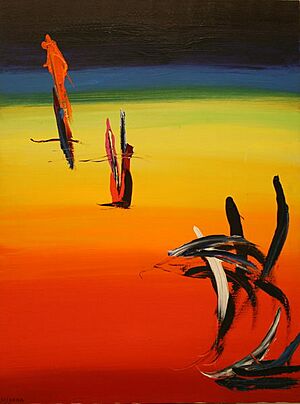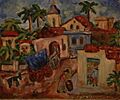Soshana Afroyim facts for kids
Quick facts for kids
Soshana Afroyim
|
|
|---|---|
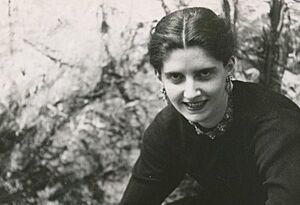
Soshana Afroyim in her studio in Paris, 1956
|
|
| Born |
Susanne Schüller
September 1, 1927 Vienna, Austria
|
| Died | December 9, 2015 (aged 88) Vienna, Austria
|
| Nationality | Austrian |
| Education | Northwood College Chelsea Polytechnic School University of Applied Arts Vienna Academy of Fine Arts Vienna |
| Known for | Painting |
| Movement | Modernism |
| Spouse(s) | |
Soshana Afroyim (born Susanne Schüller; September 1, 1927 – December 9, 2015) was an Austrian painter. She was known for her modern art. Soshana was a full-time artist. She traveled often and showed her art all over the world.
During her travels, she painted many famous people. Her art changed a lot over time. At first, her paintings looked very real, like landscapes and portraits. Later, her style became more abstract. This means her art focused on shapes, colors, and lines, not just real-life things. She was greatly inspired by Asian calligraphy, which is a beautiful way of writing.
Contents
Life Story of Soshana
Early Life and Family
Soshana Afroyim was born Susanne Schüller in Vienna, Austria, in 1927. Her family was Jewish and middle-class. Her younger brother, Maximilian, was born two years later. Her father, Fritz Schüller, owned a factory that made cufflinks. Her mother, Margarethe Schüller, was a sculptor. Soshana started painting and drawing when she was very young. Her mother supported her creativity and kept her early artworks.
Fleeing from Vienna
When Soshana was eleven, she saw Hitler take over Austria. She remembered looking out the window and seeing him welcomed by cheering crowds. She felt very cold and scared.
Her family decided to leave Austria. Her father, who had a Czech passport, left first. Soshana, her mother, and brother fled to Switzerland, then Paris. In 1939, they reached London, where they stayed for two years. Soshana went to Northwood College and the Chelsea Polytechnic School. There, she took painting and drawing lessons. She also learned about fashion design.
During this time, London was bombed often in what was called the Blitz. The family had to hide in air-raid shelters almost every night. This was very stressful for Soshana. She used her drawings to express her feelings.
Moving to America
Soshana's father went to Spain, then to New York. In 1941, he helped his family get permission to join him. They booked tickets on the S.S. Madura, which was the last civilian ship leaving Europe. In 1941, Soshana, her mother, and her brother arrived in New York City.
Soshana went to Washington Irving High School. She took painting classes with an artist named Beys Afroyim. He would later become her husband.
Traveling Across America
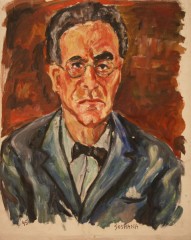
When she was 17, Soshana traveled across America with Beys Afroyim. Her parents did not want her to go. To earn money, they painted famous people. These included writers like Thomas Mann and musicians like Otto Klemperer.
In May 1945, the United Nations Conference on International Organization began in San Francisco. Soshana and Afroyim painted portraits of important people there.
Soshana and Afroyim got married in 1945. Their only child, Amos, was born in New York in 1946.
Cuba and First Big Show

The couple moved to Cuba for nine months. In 1948, Soshana had her first art show there in Havana. From that time on, she used the name "Soshana." Beys Afroyim gave her this name. It means "Lily" in Hebrew.
After a short time back in the US, they moved to Europe and then to Israel. The family did not have much money. Soshana did not want to be a traditional housewife. She and Beys divorced in 1950. She returned to Vienna with her son in 1951.
Vienna and Paris Years
Back to Vienna
Soshana returned to Vienna with her son. She later gave Beys full custody of Amos. In 1951, she studied at the University of Applied Arts in Vienna. In 1952, she went to the Academy of Fine Arts Vienna. She painted under famous professors there. But she was not happy with the way art was taught. So, in 1952, she moved to Paris, France.
Life in Paris
In Paris, Soshana lived and worked in art studios that famous artists had used before. One studio was next to Brâncuși, a well-known sculptor. She became very close with him. She said he loved her "like a daughter." Later, she lived in a studio that Gauguin had once owned.
Soshana found it hard to make enough money as an artist in Paris. She called it a "bittersweet time." She met many other artists, including Pablo Picasso. In 1954, Picasso invited her to his home and drew a portrait of her. A gallery owner named Max G. Bollag also became a big supporter of her work.
Soshana had many art shows in Paris. She showed her work in important art salons.
Traveling the World
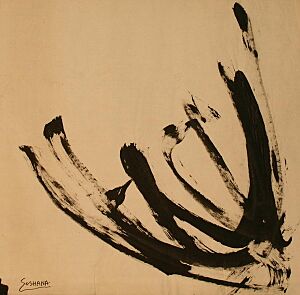
In 1956, Soshana traveled across Asia. She arranged to have an art show in Beijing, China. On her way, she visited India, Thailand, Cambodia, and Japan. She became very interested in Indian ideas and religions like Hinduism and Buddhism.
She loved the art of calligraphy. She learned how to paint on rice paper from Buddhist monks in Kyoto. She also learned from Chinese painters in Hangzhou. Calligraphy became a very important part of her painting style. In 1957, her exhibition opened in the Emperor's palace in Beijing.
In 1959, Soshana traveled through Africa. She painted a portrait of Albert Schweitzer there. Then she returned to Paris.
That same year, she met Italian artist Pinot Gallizio. They worked together in Paris and Italy. Gallizio wrote that their shared paintings were "formidable."
Through Gallizio, Soshana met artists from the COBRA group. But because she was a woman, they did not let her become a full member.
Instead, Soshana worked with the O'Hana Gallery in London. She had three shows there. In 1962, she had an exhibition at Château Grimaldi in Antibes.
Time in Mexico
In 1964, Soshana traveled to Mexico for several art shows. She lived for many months in Cuernavaca. This city was known as the "City of Eternal Spring." Many artists and thinkers lived there in the 1960s. She became friends with Mexican artists like Rufino Tamayo. In 1966, her art was shown in the Palacio de Bellas Artes.
Second World Journey
In 1968, Soshana took her second trip around the world. She visited the South Seas, the Caribbean, Thailand, Bali, Australia, India, and Israel. In 1969, the king of Sikkim asked her to paint portraits of him and the queen. That same year, she joined the Theosophical Society.
In 1972, Soshana moved to Jerusalem. She planned four art shows there. But the Yom Kippur War started, and all her shows were canceled. Soshana left Israel and moved to New York in 1974.
Living in New York

From 1974 to 1985, Soshana lived and worked in New York City. She stayed at the Hotel Chelsea at first. She could pay her rent with her paintings. Soshana knew many people in the New York art world. Her close friend was Adolph Gottlieb. Even though her art was known internationally, Soshana did not feel happy in New York. She returned to Vienna in 1985.
Return to Vienna
After returning to Vienna, Soshana continued to travel. But in 2005, she had to stop because of health problems. She moved to a nursing home and kept painting. She passed away on December 9, 2015. Her son, Amos, now manages her art. In 2008, the Austrian National Library took over her creative works. This included her writings, photos, and letters.
Soshana's Artworks
Early Art Style
In her early work, Soshana combined ideas from Fauvism with American Realism. Her art from this time showed a youthful, carefree spirit.
Soshana's first strong art influences came from an art school in New York City. She was 14 years old. Before she started making abstract paintings in the early 1950s, she painted in a colorful, realistic style. This style was connected to the political art of the 1940s.
The bombings in London during The Blitz made Soshana start drawing about her feelings. Her teacher and later husband, Beys Afroyim, was a strong supporter of communism. He led her deeper into art that told stories and showed everyday life, known as Social Realism. Afroyim and Soshana were very active in the political art groups in New York. Many European immigrants were part of these groups.
As she traveled with Beys Afroyim, Soshana painted street scenes and factory workers. She also painted people she met and many landscapes. She created portraits of artists and politicians. These portraits showed the thoughtful people the Afroyim couple spent time with.
Soshana's paintings of working-class people were similar to those by famous American artists. These artists focused on showing American life.
Until 1948, Soshana kept her realistic, colorful, and strong Social Realism style. In these early paintings, figures were painted simply with broad brush strokes. Landscapes often looked like they were seen from a slightly high view. The scenes usually had a neutral light. But the bright colors gave them a cheerful feeling, like the art style called Fauvism.
When she returned to Vienna in 1951, Soshana started painting European mountain landscapes. These paintings showed her first steps towards a new art style called Art Informel.
Paris, Asia, and Abstract Art
When Soshana moved to Paris in 1952, she became part of the "École de Paris." This was a group of artists in Paris.
Being around artists from all over the world changed Soshana's style. She moved from realistic art to Informel art. She slowly removed real objects from her paintings. She followed the new international art trends after 1945. Experts compare her Paris paintings to those of Jackson Pollock and Hans Hartung.
From the mid-1950s, Soshana's art showed more Informel qualities. Like many artists then, she loved Asian calligraphic art and its ideas. She had many Asian friends in Paris and started trying out calligraphic techniques. But her first trip to Asia in 1957 was the biggest influence. She learned to use Chinese ink on paper. Soon, she used this new technique in her oil paintings.
Even though she painted a lot of abstract art, Soshana never fully stopped painting things that looked real. She often added figures into her abstract works.
Mexico and Surrealism
Many of Soshana's paintings have Surrealistic ideas. This means they show dream-like or strange scenes. You might see a never-ending horizon or huge, empty spaces. Mysterious shapes, masks, or heads seem to float in these spaces.
Soshana's travels to Mexico influenced her use of Surrealism. She first visited Mexico in 1960. At that time, Mexico was a welcoming place for artists and thinkers from Europe.
Soshana loved Mexico deeply. This connection shows in her art. The paintings she made in Mexico, or those that remind her of Mexico, have a special feel. They use the bright colors and strong contrasts of that country.
Soshana also improved a painting technique she found by accident. One day, rain leaked through her studio roof onto her watercolors. It left bright spots with dark edges when it dried. Soshana began to copy this effect with turpentine on her oil paintings. She called the result a "kind of drip painting in reverse." She said her paintings looked like what you see when you look into a microscope.
Themes of Loneliness and Pain
Lonely figures, dark shapes, or single heads behind heavy bars are common in Soshana's art. These images appear again and again. They have given her a reputation as an artist who showed "anxiety and loneliness, of disease and dementia, of unemployment, pain, and death." (The Mainichi, Japan 1957)
Art About Politics
Political events deeply affected Soshana from her childhood. When she was 11, she saw Hitler enter Vienna. Later, her family had to run away from the Nazi government. Soshana used drawing and painting to deal with these difficult experiences. For example, she made a drawing called "Hitler as Clown."
Topics like The Cold War, the Yom Kippur War, the atomic age, and terrorism appear often in Soshana's art. When she returned to Vienna in 1985, she focused on the Nazi period and the Holocaust. During a political campaign in 1987/88, she made paintings and collages. She included Nazi propaganda texts in them. Soshana also painted about the wars in Yugoslavia, the attacks on the World Trade Center, and the Iraq War.
Later Artworks
In Soshana's later art, you can see ideas from her earlier works. Her paintings from the 2000s look different. The shapes are calmer, the colors are clearer, and the forms are simpler. Sometimes, the pictures even seem childlike and innocent. These artworks are like little puzzles, full of humor and imagination.
Awards and Recognition
- March 2008: Österreichische Post (Austrian Post) released a special stamp called "Soshana" in their "Modern Art in Austria" series.
- September 2, 2009: She received the Gold Merit Award from the Province of Vienna.
- May 27, 2010: She was given the Austrian Cross of Honour for Science and Art.
Selected Exhibitions
Soshana's art was shown in many places around the world. Here are some of her important exhibitions:
- 1948: Circulo de Bellas Artes, Havanna, Cuba
- 1957: Imperial Palace, Beijing, China
- 1960: Museo de Arte, São Paulo, Brazil
- 1961: Soshana, Musée Picasso, Antibes, France
- 1966: National Museum of Modern Art, Mexico City, Mexico
- 1973: Old Jaffa Gallery, Israel
- 1976: Modern Art Centre, Zurich, Switzerland
- 1982: Horizon Gallery, New York, USA
- 1997: Soshana-Retrospective, Palais Pálffy, Vienna, Austria (a big show looking back at her whole career)
- 1998: Lentos Museum, Linz, Austria
- 1999: Musée Matisse, Le Cateau-Cambrésis, France
- 2006: Book Presentation, Jewish Museum, Vienna, Austria
- 2007: Siddhartha Art Gallery, Kathmandu, Nepal; Agora Gallery, New York, USA; Givatayim Theater, Israel
- 2008: Khalil Sakakini Cultural Center, Ramallah, Westbank; City Council of Lima, Pancho Fierro Art Gallery, Peru
- 2009: Yeshiva University Museum, New York, USA; National Bank of Serbia, Belgrade, Serbia; UCLA Hillel Museum, Los Angeles, USA
- 2012: Lilly's Art, Vienna, Austria; an exhibition for Soshana's 85th birthday
- 2013: Exhibition at the Art Center of the Bahrain National Museum
- 2013: Austrian National Library, Vienna: "Night over Austria. The annexation 1938 - Flight and expulsion," a group exhibition about Austrian artists who fled during the Nazi era.
- 2013: Exhibition at the Galicia Jewish Museum Kraków, Poland
- 2013: National Library of Austria, Vienna
- 2013: Gallery Art Couture Dubai, UAE
- 2013: Al-Babtain Library Kuwait
- 2014: Gallery del Ponte Turin, Italy
- 2014: Gallery Szaal, Vienna
- 2015: Theater Nestroyhof/Hamakom, Vienna
- 2015: Deutschvilla Strobl at Wolfgangsee, Austria
- 2015: Gallery Lendnine, Graz
- 2016: Gallery Art Couture Dubai, UAE
- 2017: Kunsthall Oslo with Edvard Munch Museum Oslo, Norway
- 2017: Austrian Cultural Forum in Istanbul, Turky
- 2017: Austrian Cultural Forum New Delhi, India
- 2017: Austrian Cultural Forum London, UK
- 2018: Made in Art Gallery Venice, Italy
- 2018: Galerie ART nou mil.lenni, Barcelona, Spain
- 2019: Stadtgalerie Kitz-Art, Kitzbühel, Austria
- 2019: Kleine Galerie, Vienna, Austria
- 2019: Weltmuseum Wien, Heldenplatz, Vienna, Austria
- 2019: Shanghai Art Collection Museum, China
- 2020: Amart Galerie – Austrian Modern Art, Vienna, Austria
- 2020: Deutschvilla Strobl, Strobl am Wolfgangsee, Austria
- 2021: Fondazione Centro Giacometti, Switzerland
- 2021: Deutschvilla Strobl, Strobl am Wolfgangsee, Austria
- 2022: Palais Palffy, Vienna, Austria
- 2022: Deutschvilla Strobl, Strobl am Wolfgangsee, Austria
- 2022: Never at Home, Vienna, Austria
- 2022: Legenstein & Partner, Vienna, Austria
- 2022: Albertina Modern: "Ways of Freedom", Vienna, Austria
- 2023: Kleine Galerie, Vienna, Austria
- 2023: Deutschvilla Strobl, Strobl am Wolfgangsee, Austria
- 2024: Hessen Kassel Heritage, Kassel, Germany
Where to See Her Art (Museums)
Soshana's paintings are kept in many museums around the world, including:
- Albertina, Graphics Collection, Vienna
- Museum of Modern Art, Paris
- Museum of Modern Art, Rome
- Museum of Modern Art, Rio de Janeiro
- Museum of Modern Art, São Paulo
- Museum of Modern Art, Mexico
- Museum of Modern Art, New Delhi
- Museum of Fine Arts, Santa Fé
- Bezalel Museum, Jerusalem
- The Israel Museum, Jerusalem
- Helena Rubinstein Museum, Tel Aviv
- Jewish Museum, New York
- Leo Baeck Institute, New York
- New York Hospital, New York
- Stamford Museum, Connecticut
- Salisbury Art Gallery, Rhodesia
- Farleigh Dickenson University, New Jersey
- Hirschhorn Museum, Washington, DC
- Musée Matisse, Nice
- Musée Picasso, Antibes
- Petit Palais, Geneva
- Neue Galerie, Linz, Austria
- Oberbank Wien
Film About Soshana
A documentary film called Everywhere alone. The Artist Soshana tells her life story. It is 45 minutes long. The film was shot in Vienna, Paris, Mexico, and New York. It shows how Soshana's life connected with the history of the 20th century. The film includes interviews with Soshana herself and with her friends. This documentary was shown on TV in December 2013.
Other Facts
- In March 2008, a special stamp featuring Soshana's art was released in Austria.
- In September 2011, seven of Soshana's paintings were stolen from a private collection in Vienna.
- Soshana worked on her autobiography (her life story written by herself) for several years. It was never finished or published. Her son, Amos Schueller, has the manuscript.
Images for kids
-
Otto Klemperer, Conductor; oil on canvas, painted by Soshana Afroyim, 1945
-
Outside Havana, oil on canvas, painted by Soshana, 1947
-
Kyoto, ink on paper, painted by Soshana, 1957
-
NY Central Park, gouache on paper, painted by Soshana, 1975


